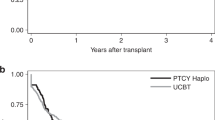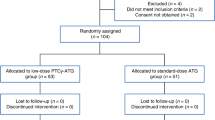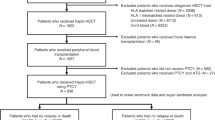Abstract
Systemic corticosteroid therapy is a well-established first-line treatment for grades II–IV acute graft-versus-host disease (aGVHD). Recently, several developments have occurred, including the introduction of transplantation from human leukocyte antigen (HLA) haploidentical donors using post-transplant cyclophosphamide (PTCY-Haplo), and improvements in prognosis after cord blood transplantation (CBT) in Japan. This study aimed to analyze the association between donor sources and outcomes in patients with aGVHD. Our study included 2732 patients who developed grades II–IV aGVHD, and were treated with systemic corticosteroids. We compared HLA-matched related donors (MRD), HLA-matched unrelated donors (MUD), PTCY-Haplo, and CBT. We set endpoint as response rate, 1-year cumulative incidence of non-relapse mortality (NRM), and overall survival (OS). The adjusted odds ratios for a complete response (CR) were 0.99 (95% confidence interval [CI]: 0.74–1.31, P = 0.925) for MUD, 2.08 (95% CI: 1.35–3.25, P = 0.001) for PTCY-Haplo, and 1.08 (95% CI: 0.83–1.41, P = 0.550) for CBT compared with MRD. A significant increase in response rates for PTCY were only found in a single-organ involvement. No significant association was observed between the donor source and NRM or OS. In conclusion, PTCY-Haplo is associated with a high response rate in patients with a single-organ aGVHD; however, MUD and CBT were not associated with treatment response.
This is a preview of subscription content, access via your institution
Access options
Subscribe to this journal
Receive 12 print issues and online access
$259.00 per year
only $21.58 per issue
Buy this article
- Purchase on SpringerLink
- Instant access to full article PDF
Prices may be subject to local taxes which are calculated during checkout



Similar content being viewed by others
Data availability
The data for this study are not publicly available because of ethical restrictions that exceed the scope of the recipient’s or donor’s consent for research use in the registry.
References
Penack O, Marchetti M, Ruutu T, Aljurf M, Bacigalupo A, Bonifazi F, et al. Prophylaxis and management of graft versus host disease after stem-cell transplantation for haematological malignancies: updated consensus recommendations of the European Society for Blood and Marrow Transplantation. Lancet Haematol. 2020;7:e157–e167.
Ponce DM, Politikos I, Alousi A, Carpenter PA, Milano F, MacMillan ML, et al. Guidelines for the prevention and management of graft-versus-host disease after cord blood transplantation. Transpl Cell Ther. 2021;27:540–4.
Bacigalupo A, Milone G, Cupri A, Severino A, Fagioli F, Berger M, et al. Steroid treatment of acute graft- versus -host disease grade I: a randomized trial. Haematologica. 2017;102:2125–33.
MacMillan ML, Robin M, Harris AC, DeFor TE, Martin PJ, Alousi A, et al. A refined risk score for acute graft-versus-host disease that predicts response to initial therapy, survival, and transplant-related mortality. Biol Blood Marrow Transpl. 2015;21:761–7.
Malard F, Huang XJ, Sim JPY. Treatment and unmet needs in steroid-refractory acute graft-versus-host disease. Leukemia. 2020;34:1229–40.
MacMillan M, DeFor T, Weisdorf D. What predicts high risk acute graft‐versus‐host disease (GVHD) at onset?: identification of those at highest risk by a novel acute GVHD risk score. Br J Haematol. 2012;157:732–41.
Martin P, Schoch G, Fisher L, Byers V, Anasetti C, Appelbaum F, et al. A retrospective analysis of therapy for acute graft-versus-host disease: initial treatment. Blood. 1990;76:1464–72.
Cragg L, Blazar BR, Defor T, Kolatker N, Miller W, Kersey J, et al. A randomized trial comparing prednisone with antithymocyte globulin/prednisone as an initial systemic therapy for moderately severe acute graft-versus-host disease. Biol Blood Marrow Transpl. 2000;6:441–7.
Weisdorf D, Haake R, Blazar B, Miller W, McGlave P, Ramsay N, et al. Treatment of moderate/severe acute graft-versus-host disease after allogeneic bone marrow transplantation: an analysis of clinical risk features and outcome. Blood. 1990;75:1024–30.
Murata M, Nakasone H, Kanda J, Nakane T, Furukawa T, Fukuda T, et al. Clinical factors predicting the response of acute graft-versus-host disease to corticosteroid therapy: an analysis from the GVHD Working Group of the Japan Society for Hematopoietic Cell Transplantation. Biol Blood Marrow Transpl J Am Soc Blood Marrow Transpl. 2013;19:1183–9.
Konuma T, Kanda J, Inamoto Y, Hayashi H, Kobayashi S, Uchida N, et al. Improvement of early mortality in single‐unit cord blood transplantation for Japanese adults from 1998 to 2017. Am J Hematol. 2020;95:343–53.
Konuma T, Mizuno S, Kondo T, Arai Y, Uchida N, Takahashi S, et al. Improved trends in survival and engraftment after single cord blood transplantation for adult acute myeloid leukemia. Blood Cancer J. 2022;12:81.
Sugita J, Kawashima N, Fujisaki T, Kakihana K, Ota S, Matsuo K, et al. HLA-haploidentical peripheral blood stem cell transplantation with post-transplant cyclophosphamide after busulfan-containing reduced-intensity conditioning. Biol Blood Marrow Transpl. 2015;21:1646–52.
Sugita J, Kamimura T, Ishikawa T, Ota S, Eto T, Kuroha T, et al. Reduced dose of posttransplant cyclophosphamide in HLA-haploidentical peripheral blood stem cell transplantation. Bone Marrow Transpl. 2021;56:596–604.
Przepiorka D, Weisdorf D, Martin P, Klingemann HG, Beatty P, Hows J, et al. 1994 consensus conference on acute GVHD grading. Bone Marrow Transpl. 1995;15:825–8.
Harris AC, Young R, Devine S, Hogan WJ, Ayuk F, Bunworasate U, et al. International, Multicenter Standardization of Acute Graft-versus-Host Disease Clinical Data Collection: A Report from the Mount Sinai Acute GVHD International Consortium. Biol Blood Marrow Transpl. 2016;22:4–10.
Sorror ML, Maris MB, Storb R, Baron F, Sandmaier BM, Maloney DG, et al. Hematopoietic cell transplantation (HCT)-specific comorbidity index: a new tool for risk assessment before allogeneic HCT. Blood. 2005;106:2912–9.
Giralt S, Ballen K, Rizzo D, Bacigalupo A, Horowitz M, Pasquini M, et al. Reduced-intensity conditioning regimen workshop: defining the dose spectrum. Report of a workshop convened by the center for international blood and marrow transplant research. Biol Blood Marrow Transpl J Am Soc Blood Marrow Transpl. 2009;15:367–9.
Bacigalupo A, Ballen K, Rizzo D, Giralt S, Lazarus H, Ho V, et al. Defining the intensity of conditioning regimens: working definitions. Biol Blood Marrow Transpl J Am Soc Blood Marrow Transpl. 2009;15:1628–33.
Mancusi A, Ruggeri L, Velardi A. Haploidentical hematopoietic transplantation for the cure of leukemia: from its biology to clinical translation. Blood. 2016;128:2616–23.
Ponce DM, Gonzales A, Lubin M, Castro-Malaspina H, Giralt S, Goldberg JD, et al. Graft-versus-Host Disease after Double-Unit Cord Blood Transplantation Has Unique Features and an Association with Engrafting Unit-to-Recipient HLA Match. Biol Blood Marrow Transpl. 2013;19:904–11.
MacMillan ML, DeFor TE, Holtan SG, Rashidi A, Blazar BR, Weisdorf DJ. Validation of Minnesota acute graft- versus -host disease Risk Score. Haematologica. 2020;105:519–24.
MacMillan M, Weisdorf D, Brunstein C, Cao Q, DeFor T, Verneris M, et al. Acute graft-versus-host disease after unrelated donor umbilical cord blood transplantation: analysis of risk factors. Blood. 2009;113:2410–5.
Mielcarek M, Storer B, Boeckh M, Carpenter P, McDonald G, Deeg H, et al. Initial therapy of acute graft-versus-host disease with low-dose prednisone does not compromise patient outcomes. Blood. 2009;113:2888–94.
Mielcarek M, Furlong T, Storer BE, Green ML, McDonald GB, Carpenter PA, et al. Effectiveness and safety of lower dose prednisone for initial treatment of acute graft-versus-host disease: a randomized controlled trial. Haematologica. 2015;100:842–8.
Acknowledgements
The authors thank all the physicians and data managers at the centers that contributed to the collection of data on transplantation for the Japanese Data Center for Hematopoietic Cell Transplantation and TRUMP2.
Author information
Authors and Affiliations
Contributions
YS designed the study, developed the models, performed statistical analysis, and wrote the first draft of the manuscript. TK, JS, TT, AS, TH, HN, and JK critically reviewed the data analysis and manuscript. YA managed the unified registry database. HN and JK advised on the methods, revised the manuscript, and were responsible for the co-project of JSTCT Donor/Source and JSTCT GVHD Working Groups, respectively. All the other authors contributed to data collection. All the authors approved the final version of the manuscript.
Corresponding author
Ethics declarations
Competing interests
The authors declare no competing interests.
Ethics approval and consent to participate statement
This study was approved by the Data Management Committee of the Japanese Data Center for Hematopoietic Cell Transplantation and the Ethics Committee of the Kobe City Hospital Organization, Kobe City Medical Center General Hospital. All methods were performed in accordance with the relevant guidelines and regulations. Patient consent was obtained prior to registration in the Transplant Registry Unified Management Program 2.
Additional information
Publisher’s note Springer Nature remains neutral with regard to jurisdictional claims in published maps and institutional affiliations.
Supplementary information
Rights and permissions
Springer Nature or its licensor (e.g. a society or other partner) holds exclusive rights to this article under a publishing agreement with the author(s) or other rightsholder(s); author self-archiving of the accepted manuscript version of this article is solely governed by the terms of such publishing agreement and applicable law.
About this article
Cite this article
Shimomura, Y., Kitamura, T., Sugita, J. et al. Impact of donor type on the outcomes of acute graft versus host disease to systemic corticosteroid therapy. Bone Marrow Transplant 59, 1763–1772 (2024). https://doi.org/10.1038/s41409-024-02424-x
Received:
Revised:
Accepted:
Published:
Issue date:
DOI: https://doi.org/10.1038/s41409-024-02424-x
This article is cited by
-
Impact of center volume on acute graft versus host disease in allogeneic stem cell transplant recipients
International Journal of Hematology (2025)



